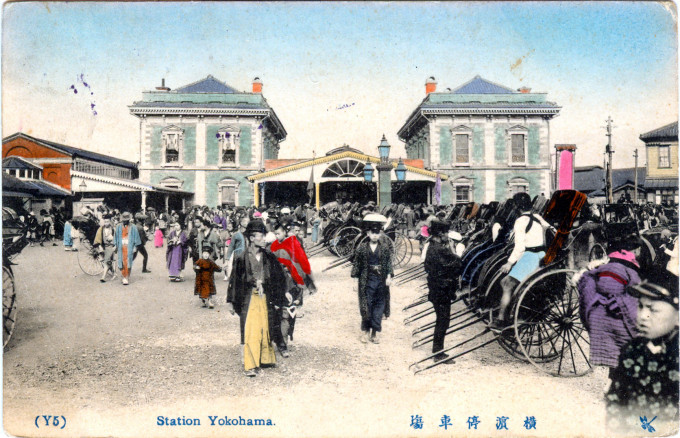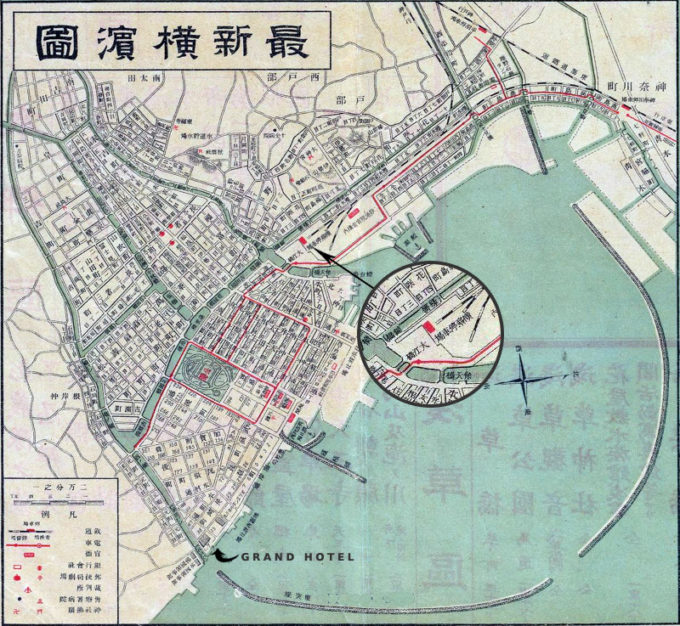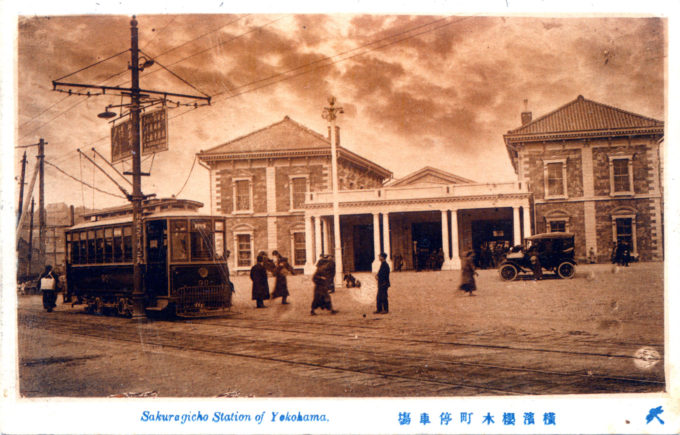
Yokohama Station, c. 1910, one of Japan’s oldest train stations. It opened on June 12, 1872, as the original Yokohama Station when the service between Shinagawa and Yokohama was first completed. (Shimbashi would become the Tokyo destination from October, 1872.) The station was renamed Sakuragichō Station in 1915 when the then-new and second Yokohama Station opened near Takashimacho.
See also:
Yokohama Station (1915-1923)
Shimbashi Station (Shiodome), 1872-1909
“The journey between [Yokohama and Tokyo] is performed in an hour by an admirable, well-metalled, double-track railroad, 18 miles long, with iron bridges, neat stations, and substantial roomy termini, built by English engineers at a cost known only to Government, and opened by the Mikado in 1872.
“The Yokohama station is a handsome and suitable stone building, with a spacious approach, ticket- offices on our plan, roomy waiting-rooms for different classes— uncarpeted, however, in consideration of Japanese clogs—and supplied with the daily papers. There is a department for the weighing and labelling of luggage, and on the broad, covered, stone platform at both termini a barrier with turnstiles, through which, except by special favour, no ticketless person can pass. Except the ticket-clerks, who are Chinese, and the guards and engine-drivers, who are English, the officials are Japanese in European dress.
50th Anniversary of Japanese Railroads commemorative postcard, 1922. The blessing of Sakuragicho (Yokohama) Station with Shinto rites, June 12, 1872.
“Outside the stations, instead of cabs, there are kurumas [jinrikisha], which carry luggage as well as people. Only luggage in the hand is allowed to go free; the rest is weighed, numbered, and charged for, a corresponding number being given to its owner to present at his destination. The fares are — 3rd class, an ichibu, or about 1 shilling; 2nd class, 60 sen, or about 2s. 4d.; and 1st class, a yen, or about 3s. 8d. The tickets are collected as the passengers pass through the barrier at the end of the journey. The English-built cars differ from ours in having seats along the sides, and doors opening on platforms at both ends.
“On the whole, the arrangements are Continental rather than British. The first-class cars are expensively fitted up with deeply-cushioned, red morocco seats, but carry very few passengers, and the comfortable seats, covered with fine matting, of the 2d class are very scantily occupied; but the 3d class vans are crowded with Japanese, who have taken to railroads as readily as to kurumas.
“You don’t take your ticket for Tokio, but for Shinagawa or Shinbashi, two of the many villages which have grown together into the capital. Yedo is hardly seen before Shinagawa is reached, for it has no smoke and no long chimneys; its temples and public buildings are seldom lofty; the former are often concealed among thick trees, and its ordinary houses seldom reach a height of 20 feet.
“On the right a blue sea with fortified islands upon it, wooded gardens with massive retaining walls, hundreds of fishing-boats lying in creeks or drawn up on the beach; on the left a broad road on which kurumas are hurrying both ways, rows of low, grey houses, mostly tea-houses and shops; and as I was asking ‘Where is Yedo?’ the train came to rest in the terminus, the Shinbashi railroad station, and disgorged its 200 Japanese passengers with a combined clatter of 400 clogs—a new sound to me.”
– Unbeaten Tracks in Japan, Isabella L. Bird, 1878





Pingback: Yokohama Station (1915-1923). | Old Tokyo
Pingback: Grand Hotel, Yokohama, c. 1910. | Old Tokyo
Pingback: 50th Anniversary Commemoration, Imperial Government Railways, 1922. | Old Tokyo
Pingback: Yokohama Station, c. 1935. | Old Tokyo
Pingback: Shimbashi Station (Shiodome), 1872-1909. | Old TokyoOld Tokyo
Pingback: Shimbashi Station (Shiodome), 1872-1909. | Old TokyoOld Tokyo
Pingback: Yokohama Station (1915-1923). | Old TokyoOld Tokyo